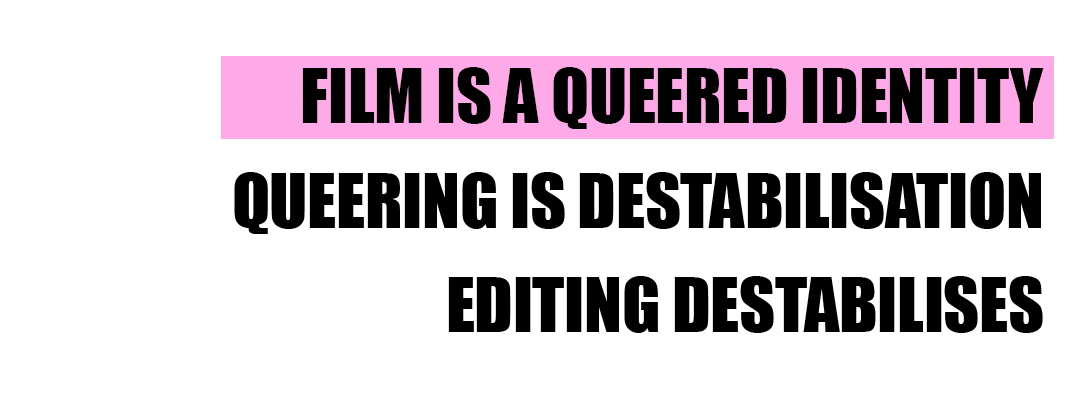








CUTTING QUEER FUTURES
A WEB EXEGESIS BY XANTHE DOBBIE
To edit is to queer time.
That is, to treat time in a way that lives outside the logic of linearity.
We augment,
digitally manipulate,
snatch fragments from multiple futures and glue them back together
to form one of countless possible outcomes.
All the trajectories laid before us,
woven together and pulled apart -
each with unique consequence.
This is a romance story. About queerness. About queering. This is a drama. About making choices - editing life. This is a historical re-enactment. About artifice. About time. This is whatever I tell you it is. Whatever you want it to be. This is none of that really. This is an argument, fighting for nothing in particular and the particularities of nothingness. This is the future, channeled through the past and trapped in the present.
Introduction
'Queer' can refer to: the open mesh of possibilities, gaps, overlaps, dissonances and resonances, lapses and excesses of meaning. (Sedgewick, 1994, p.8)
Over the past two years of research and practice I have become fascinated by the notion of queering, by the very ambiguity of the term itself, the slipperiness of its definition, which indeed defines it. There is a general consensus within queer theory that “queer is something that we do, rather than something we are (or are not)” (Barker & Scheele, 2016, p.14) - it is active. I have become particularly drawn to the way the term can be applied to filmmaking, especially in regards to editing. Before a film is edited, it is really just ideas and potential captured in time and space. It is not until these ideas converge on a timeline that a film begins to take form, to have an identity.
Queer is by definition whatever is at odds with the normal, the legitimate, the dominant. There is nothing in particular to which it necessarily refers. It is an identity without an essence. 'Queer' then, demarcates not a positivity but a positionality vis-à-vis the normative. (Halperin, 1995, p.62)
Queer can be many, many things, and generally, it’s defined by what it’s not. So, for the purposes of this research, I am drilling “queer” down to its core as an act of destabilisation – it is rebellion against form and expectation; against normativity. As such, this web exegesis follows a more fluid approach structurally and does not include a traditional source review section. Rather, theory and practice are discussed in tandem throughout. Championing non-linearity and intertextuality, hyperlinks, graphics and video content are smattered throughout, offering the reader multiple points of entry.*
*While it is recommended that the viewer read the text in the following order: Introduction, Alienation, Intertextuality, Queer Temporality, Conclusion, there is no obligation to do so.

Research Question: How can destabilisation techniques enacted by editing be used to queer cinema?
Using this question as a starting point, it is my intention to demystify editing practice and open up a discourse between queer theory and the editing process, an area, which to this point, and to my knowledge, has not been discussed at length within queer or film theory. Through the analysis of my work editing and directing the short queer film ELAGABALUS in correlation with broader artistic influences and theoretical texts, I intend to highlight the queer potential of editing as an active participant in complex, experimental storytelling. Further, as a practitioner, I view my creative work in its own right as a contribution of new knowledge to both film and art sectors.
It is my position that editing is the means by which queering is performed. While there are many ways to queer something, for the purposes of this research I hone in on three key modes of destabilisation which I have identified as common traits of queer(ed) cinema, and which have been harnessed in the creation of ELAGABALUS.
These modes are:
-
Alienation; Artifice, construction and emotional distancing to promote critical reflection
-
Intertextuality; Shifting styles, genre-clash and the refusal of definition
-
Queer Temporality; Reworking time and pushing against linearity
While these modes of destabilisation are not exclusive to queer(ed) cinema, extending on the writings of queer film scholar B. Ruby Rich (2013), I note that combinations and versions of them do often feature; adding to and emphasising the non-traditional subject matter and experimental form of the films themselves.

Within this research, I am interested in the way that an actual text (film) can be queered through editing. While there is much cinema that includes queer content, I am interested in the queered artefact – the thing in itself is queer, not just the story or the characters.
Using practice-based research to explore the queering potential of editing, I analyse the identified modes of destabilisation within the context of the development of ELAGABALUS - a film that is queer, and also queered. While editing is at the forefront of this research, I also talk to the directorial decisions made within the creative process that had an impact upon the edit. Extensive reading and viewing has informed my approach to both practice and research and I draw on queer theory, Brechtian technique, poststructuralism, postmodernism, editing and film theory to position my work. This exegesis is broken down into sections (Alienation, Intertextuality, and Queer Temporality), each of which includes a case study of a queer moving image work. As my creative practice sits somewhere between film, art, and internet culture, I analyse works from the worlds of film, art, and pornography including; Todd Haynes’ Poison (1991), Soda_Jerk’s TERROR NULLIUS (2018), and Brooke Candy’s I Love You (2018), all of which served as inspiration for ELAGABALUS.


ELAGABALUS is a short experimental queer film. Made in collaboration with other Masters students and external creatives across 2018 and 2019, I assumed the roles of both Editor and Director. Initially inspired by Sir Laurence Alma-Tadema’s painting The Roses of Heliogabalus (1888) and passages from the Historia Augusta, ELAGABALUS is based on a liberal adaptation of a real historical figure of the same name.
“Burdened by a prophecy that dooms them to a most violent death” (Herriman, 2019, p.2), Elagabalus, a young genderqueer Emperor, leans into a life of hedonistic fatalism, much to the dismay of their overbearing futch mother Symiamira, and their power-hungry, Adonis-esque lover Hierocles. After lashing out in a murderous spree, Elagabalus meets their fate when Symiamira and Hieorcles form an unlikely alliance. Told through a chorus of gender-fuck drag performers and a disco-inspired musical number, the film crescendos in a live reimagining of Alma-Tadema’s painting.
An extension of my pre-existing visual arts practice, ELAGABALUS is a queer exploration of post-internet contemporaneity. Wearing its references on its sleeve, the film drew early inspiration from a multitude of sources including, but not limited to:
-
70s sci-fi including The Holy Mountain (1973), Soylent Green (1973) and Logan’s Run (1976),
-
New Queer Cinema, particularly the works of Todd Haynes (Poison, 1991), Derek Jarman (Caravaggio, 1986, Edward II, 1991), and Jennie Livingston (Paris Is Burning, 1990),
-
The visual arts practices of Matthew Barney, David Lachapelle and Soda_Jerk,
-
Pop culture spanning Kanye West music videos, the Queens of Rupaul’s Drag Race, and Brooke Candy's cross-disciplinary online output,
-
The internet, Instagram meme accounts, and hyperactive group chats.
With a mind more geared towards non-traditional modes of making, I sought out Scriptwriter Samuel Herriman to refine my initial ideas and whittle them down into a logical, though highly flamboyant three-act structure. Directorially, the structural integrity of the script allowed me to focus on visual decadence and heightened performance in consultation with Cinematographer Sidat de Silva, Production Designers Lily Bennett and Max Boutwell Draper, Costume Designer Will Tran, and Performance Consultant Harriet Gillies. The film was shot to make room for editorial flexibility and it was in the edit that the true artistic form of ELAGABALUS begun to take shape. Beyond this, extensive collaboration with Composer Jorde Heys and Sound Designer Rowan Yeomans has further enhanced and characterised the film, bringing it into its own unique (albeit hyper-referential) audiovisual universe.
Straddling the worlds of art and cinema, ELAGABALUS is intended for potential exhibition or circulation within both areas - distribution and marketing plans being at the forefront of ongoing conversations with Producer Alexis Talbot-Smith and AFTRS. Our intention is to submit to multiple festivals, our top picks being the Berlinale and TIFF. Artistically, the film would be well suited to institutions like MCA and MONA for their pre-existing interest in moving image works.




Above: Collection of preliminary mood boards from ELAGABALUS pre-production